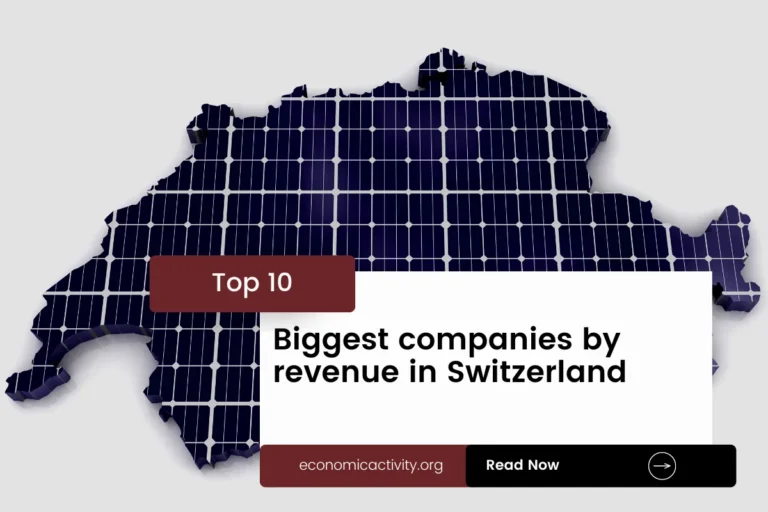United Kingdom, with a population of 66,971,395, is ranked 21st globally, just behind France. Located in Europe, it covers 243,610 sq. km, ranking 77th worldwide, just below Guinea.
The United Kingdom stands as a prominent economic power in 2022, with a GDP of $3,089,072,724,400.14, ranking 6th globally. It follows closely behind India, which holds the 5th position with a GDP of $3,416,645,826,052.87. In terms of GDP per capita, the UK ranks 26th with $46,125.2558.
It lags behind New Zealand, which ranks 25th with a GDP per capita of $48,418.5917. The UK’s diverse economy, strong financial sector, and global trade relationships contribute significantly to its robust economic position on the world stage.
What are the economic activities of United Kingdom?
- Primary activities: 0.7% of GDP.
- Secondary activities: 20.2% of GDP.
- Tertiary activities: 79.2% of GDP.

Primary Sector of United Kingdom
The primary sector in the United Kingdom, particularly its agricultural activities, thrives due to its temperate climate and rich natural resources. Agricultural land covers 71.16% of the country, with main products including milk, wheat, barley, sugar beets, potatoes, chicken, rapeseed, oats, pork, and beef.
Despite contributing only 0.7% to the GDP, agriculture plays a vital role in the economy by providing a diverse range of crops and animal products. These products not only support the agricultural sector but also contribute to the country’s food security and rural employment.
The country’s geological diversity provides a rich array of natural resources, including coal, petroleum, natural gas, iron ore, lead, zinc, gold, tin, limestone, salt, clay, chalk, gypsum, potash, silica sand, slate, and arable land. These resources play a significant role in the economy, supporting industries such as mining, agriculture, and energy production.
The United Kingdom’s oil economic activity is a key player in the global market, ranking 11th in oil production with around 810,531 barrels per day. With oil reserves totaling 2,754,685,000 barrels, the country holds 0.16% of the world’s oil reserves, contributing significantly to its economic growth and stability.
The United Kingdom’s natural gas production in 2020 reached 40,600 million m³, ranking 20th in the world. This gas economic activity contributes significantly to the country’s energy production sector, bolstering its overall economy.
Secondary Sector of United Kingdom
What is the secondary sector or what are secondary activities?
The secondary sector involves industries that transform raw materials from primary activities into finished products for consumption. In the United Kingdom, main industrial products include machine tools, electric power equipment, automation equipment, railroad equipment, shipbuilding, aircraft, motor vehicles, electronics, metals, chemicals, coal, petroleum, paper products, food processing, textiles, clothing, and other consumer goods.
Manufactures play a crucial role in the total exports of the United Kingdom, accounting for a significant 60.45% in 2023, highlighting their importance in driving the country’s economy and global trade.
Tertiary sector of United Kingdom
What is the tertiary sector or what are tertiary activities?
The tertiary sector in the United Kingdom encompasses various services where individuals provide knowledge and time to enhance productivity and meet needs. This sector involves intangible goods like advice, expertise, and attention, catering to both consumer and business-to-business needs. Key tertiary activities in the UK include healthcare and medical care, education and training, banking and finance, communication and information exchange, media production and distribution, tourism and hospitality, and transportation and logistics.
Among these, The tourism industry plays a pivotal role in the UK’s economy. With over 40 million annual arrivals, contributing significantly to the GDP, it’s a thriving sector. London and Edinburgh stand out as popular destinations, offering rich cultural experiences and iconic landmarks that attract millions of visitors yearly, driving economic growth and employment opportunities.
Another example of tertiary economic activity is the mobile cellular sector, with approximately 82 million subscriptions, equating to 121 per 100 inhabitants. This extensive network fosters technological innovation and connectivity, supporting various industries and enhancing overall economic growth.
Military Activities and Economic Sectors of United Kingdom
The military is a good example of many economic activities working together. In the primary sector, the military uses resources like metals and fuels. The secondary sector involves making military equipment, such as weapons and vehicles. The tertiary sector includes services like training and support. The quaternary sector focuses on research and development for new technology, while the quinary sector deals with high-level decisions and strategies for defense.
In 2023, the United Kingdom’s military expenditure was about 74,942.8 million US dollars, which is 2.22% of its GDP. The active military force has 196,453 personnel, giving a rate of 4.2 active military members for every 1,000 people in the country.
Biggest company in United Kingdom
Which is the biggest company in the United Kingdom? It’s Shell, a leading player in the energy industry. With a market value of $211.1 billion, Shell focuses on oil and gas production. Founded in 1907, it plays a crucial role in the UK’s economy and energy supply.
International Trade of United Kingdom
Import Activities of United Kingdom

The United Kingdom’s import activities are of high importance, accounting for 36.09% of its GDP in 2023, totaling $791.64 billion.
The United Kingdom’s key import activities include natural gas, cars, crude petroleum, gold, and garments. Major import partners are China (12%), Germany (10%), US (10%), Norway (8%), and Netherlands (5%).
Exports Activities of United Kingdom

In 2023, the United Kingdom’s total exports amounted to $521.18 billion, accounting for 33.43% of its GDP. This indicates a medium level of importance, highlighting the significant role export activities play in the country’s economy.
The United Kingdom’s export activities are diverse, with major partners like the US, Netherlands, Germany, China, and Ireland. Key export commodities include gold, cars, gas turbines, crude petroleum, and packaged medicine.
United Kingdom economy challenges in 2024
In 2024, the United Kingdom continues to face challenges with sluggish growth, reduced business investment, and post-Brexit trade frictions. High public debt necessitates fiscal austerity, impacting productivity and participation rates. The country’s global financial center status is at risk due to stringent monetary policies.




Leave a Reply